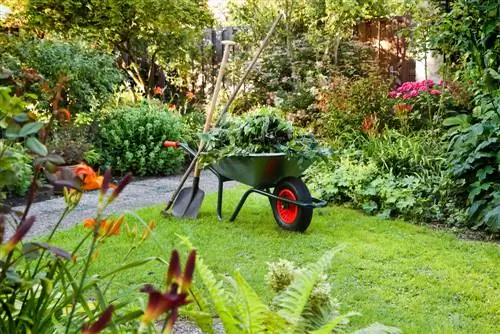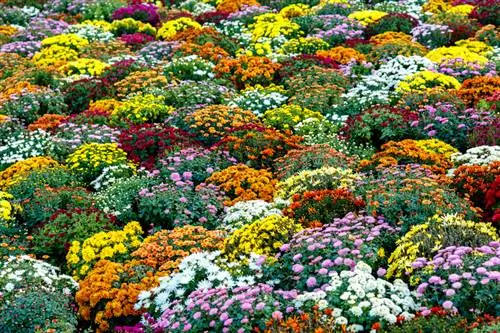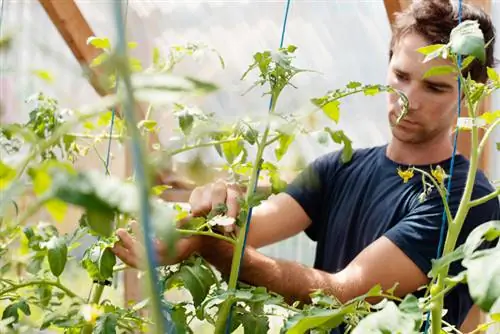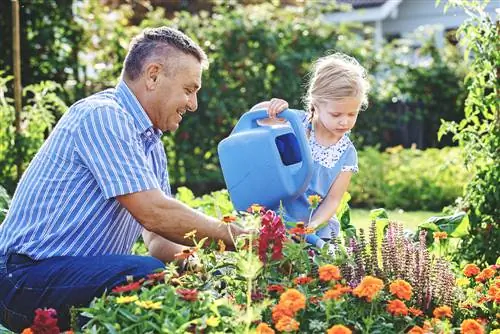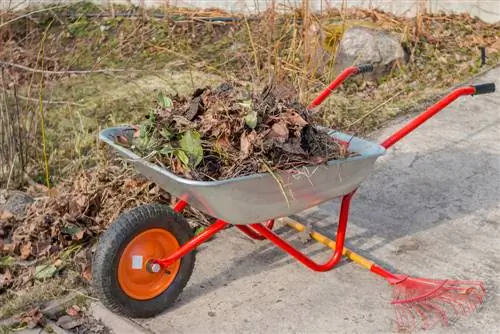- Author admin [email protected].
- Public 2024-01-02 03:03.
- Last modified 2025-01-23 11:19.
There is a lot to do in the garden all year round. In this article you will learn what gardening work needs to be done in which month. Then nothing will be forgotten and nothing will stand in the way of a well-kept garden!
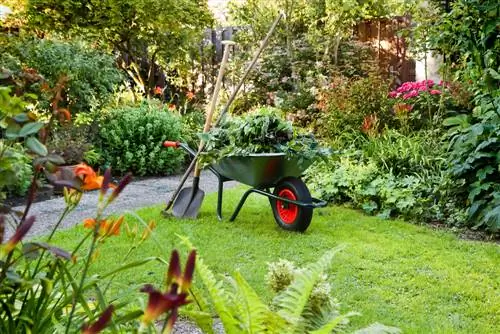
Gardening throughout the year
In this article you will find detailed advice on when certain gardening tasks should be carried out throughout the year. However, don't be too slavish when implementing it, because the actual weather conditions at your location have the greatest influence on when certain activities can be completed - or, better yet, when you should wait to do them. Planting out too early, for example, doesn't make sense if it's still frosty outside and your plants have no chance of survival - even if the calendar shows the first day of spring. Let the weather conditions where you live be your guide and see this garden calendar as just a suggestion, then you have the best chance of success.
Gardening in spring
In spring the days become longer again, the temperatures rise and the garden comes to life again: the trees show new leaves and shoots and flower bulbs hidden in the ground produce a vibrant display of colors after the gray winter. Gardeners now have a lot to do because they have to sow and plant, cut and fertilize. But be careful: Don't let the early arrival of spring fool you, because Father Frost can make a comeback in these changeable months. Even if the weather seems friendly enough for planting, it's best to continue to pay attention to the forecast - a sudden late frost can wipe out young plants in one fell swoop.
General tasks
The following table shows which general gardening tasks await you in early spring:
| Task | Implementation |
|---|---|
| Fertilize | Fertilize cut-back plants in winter and apply a generous layer of mulch. |
| Mulching | Mulch borders and paths provided the soil is moist and weed-free. |
| Digging | Prepare the soil for planting by digging. |
| Weeding | Remove perennial weeds from the beds. Clean driveways and paths. |
| Water | As the weather gets warmer and there is no rain for a long time, you need to ensure adequate watering during this most important growing period. |
March
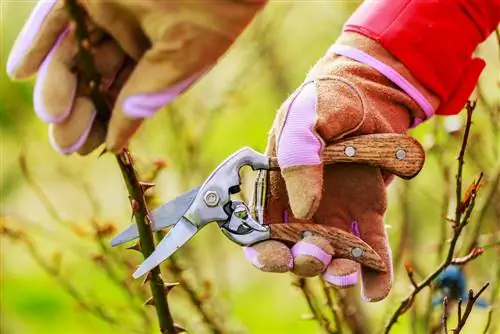
Roses are cut in March
The gardening year begins in March. Start the new season by tidying up the garden and keeping it tidy after the winter:
- Cut back wilted and dead plant parts.
- Rake the beds and borders vigorously.
- Remove any leaves or mulch left over from the previous year.
- Prune plants such as roses and other flowering plants.
- Perennials also receive a strong pruning.
- Fruit trees can also be cut now.
- Chop up the clippings and compost them.
- Check your garden plants for diseases and pests.
- Treat if necessary.
- Replace damaged planters.
The perfect time for pruning roses is traditionally when the forythia is in bloom. Summer flowering plants such as clematis, hydrangeas or lavender can also be pruned now. Pay more attention to diseases, as plants weakened by the winter are now particularly vulnerable. Remove infected plant parts and dispose of them with household waste.
If you haven't done it yet, prune your fruit trees now. Only peaches and sweet cherries are pruned in the summer after harvest. Prepare everything for the coming harvest by growing frost-sensitive vegetables such as tomatoes, peppers and cucumbers on the windowsill. However, more robust plants such as early radishes, kohlrabi or radishes, which you can sow or plant in the ground as early plants, can be placed directly in the cold frame.
You can also plant annual summer flowers such as sweet peas or snapdragons now and then plant them as young plants in the bed from April. The sooner you can enjoy the pretty flowers.
Berry bushes such as gooseberries can be planted now, and the strawberry bed also needs to be prepared for the new season. Remove wilted and dead plant parts (preferably with sharp scissors!), pull out weeds, loosen the soil and incorporate some composted manure as fertilizer. Alternatively, you can also use berry fertilizer.
The lawn is happy about this maintenance work in March:
- Rake over bare or expired areas and reseed.
- Lime if necessary.
- Weed the grass, fertilize the lawn and apply moss killer if necessary.
- Once the grass begins to grow in established lawns, you can mow.
April
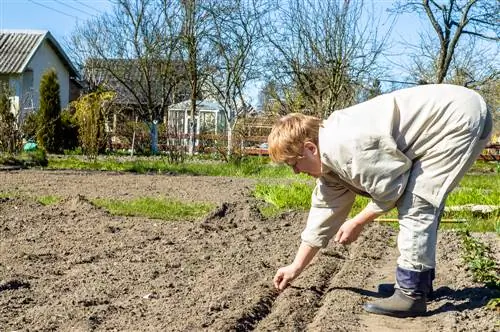
From April, cold-tolerant vegetables are sown in the bed
The preparatory work is completed in April, now the garden work is just getting started. Fertilize all garden plants that need it - this particularly applies to perennial shrubs and perennials, but also bulbous flowers and vegetable plants. The plants need the fresh supply of nutrients because they have the greatest growth spurt at this time and need energy and nutrients accordingly. Plants that are malnourished in spring will only develop poor growth as well as a lack of flowers and few fruits.
Adequate watering is also important now, especially if there is little rain in April. But there can be many a hot day that puts the plants under stress. It is best to water early in the morning, which is particularly important in gardens that are increasingly threatened by snails - here you should definitely not water in the evening, as this only attracts the animals further.
In addition, frost-resistant vegetables can be sown directly into the bed from April. However, make sure not to sow all the seeds at the same time, but rather to plant them in the soil at different times. Ultimately, you don't harvest the vegetables all at once (and get flooded), but rather gradually. Robust perennials can now also be planted and summer flowers can be sown (as long as they are not sensitive to frost). Be sure to incorporate compost beforehand so that the plants have sufficient nutrients available.
If you haven't done your lawn in March, you should do it now at the latest
- lime and fertilize (with a time delay of course)
- scarify and remove felt and dead material
- reseeding bare spots
May
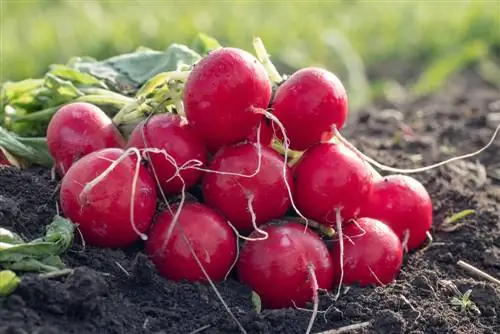
The first radishes can be harvested in May
In May you can look forward to the first harvest - provided of course you sowed and planted early. Radishes, spring onions, spinach, lettuce and chard can already be harvested. Kohlrabi and radish are also ready early. May is also wild garlic month: Do you have the spicy herb in your garden? If not, then it's high time to cultivate it!
In May, the weather often gets exciting again, as the Ice Saints often cause another cold snap in the middle of the month. However, once this is over, you can now take cold-sensitive plants outside. This not only applies to potted plants such as bougainvillea, oleander, geraniums and the like, but also to many popular vegetables such as tomatoes and peppers. Beans, zucchini and cucumbers are also quite sensitive and are only now allowed outside. The same applies to many herbs that you have ideally preferred and that are now added to the bed.
However, even after the Ice Saints, make sure to protect sensitive plants from the cold and cover them with a fleece. Otherwise, when it comes to care, you now have the same tasks as in April:
- fertilize (if not already done)
- ensure an adequate water supply
- Weeding and preventing weeds (e.g. by mulching)
- Loose the soil in the beds
It is also important to carefully check the garden plants for aphids. These pests spread in the garden quite early in the year, which is why it makes sense to combat them early - the less you have to worry about a real pest later on. Snails should also be collected regularly and the beds should be protected from the voracious animals by taking appropriate measures.
Tip
Don't forget to prick out your seedlings now so that the young plants have enough space to grow.
Gardening in summer
As temperatures rise, the economical use of water and the necessary watering of all plants becomes the gardener's main concern. Think about how your plants will survive your upcoming vacation. To do this, for example, place potted plants in the shade and, if possible, arrange mutual holiday garden care with a gardening friend.
General activities
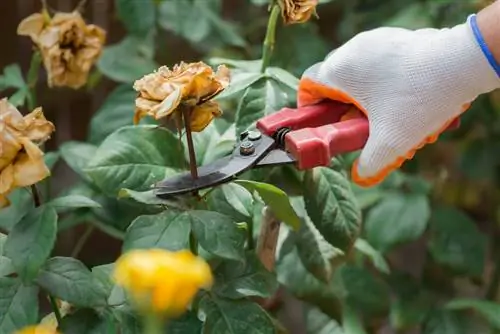
Withered flowers should be cleaned out regularly
In general, these tasks are waiting for you in summer:
| Task | Implementation |
|---|---|
| Plant pots | Now you should plant your planters or put them outside. |
| Removing faded flowers | Remove dead flowers regularly to promote the growth of new flowers and prevent disease. |
| Water | Water your plants regularly, especially in dry periods. Pay more attention to signs of drought stress, e.g. B. curled leaves, falling or wilting shoots and leaves. |
June
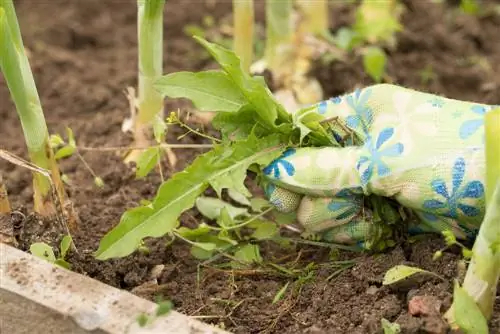
Weeds must be removed regularly
There is still a lot to do in the garden in June:
- Many plants need a second fertilization (organic or long-term fertilizer)
- Weeding
- Watering plants
- mow the lawn once a week
- Harvest sweet cherries and then cut back the tree
- Sowing annual and biennial flowers
- quickly create a herb bed (if you haven't done it yet)
- divide plants if necessary
In addition, June is high season for many pests such as scale insects, gall mites, black weevils, whiteflies and the dreaded box tree borer as well as for fungal diseases. Check your plants regularly for signs of this and take countermeasures in good time. Attract beneficial insects such as ladybirds or lacewings to the garden by setting up an insect hotel. Continue collecting snails regularly.
Excursus
When is the right time to take cuttings?
June is also the perfect time to take cuttings - at least if the plants are to be propagated from soft or semi-woody cuttings. Cut the wood and place it immediately in nutrient-poor potting soil. The following year the resulting plants can finally be placed outdoors.
July
One thing is particularly important in July: water, water and water again. Preferably water your plants early in the morning and make sure to apply the water directly to the soil. If possible, the leaves and flowers of the plants should not get wet! Otherwise there is a risk of fungal diseases. Also, do not water in small doses every day, but rather vigorously every few days - this is the only way plants can develop deep roots and are less sensitive to drought.
August
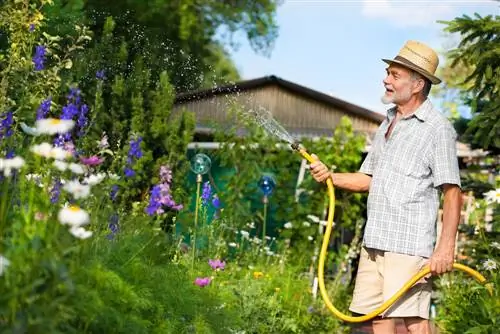
In the warmest season you need to water a lot
The most important work in August continues to be providing the plants with sufficient water as well as regularly pulling weeds and mowing the lawn. August is also the month in which you can harvest plenty of vegetables - so you'll have your hands full to finally reap the fruits of your labor.
You can either sow or plant the harvested beds with winter vegetables such as lamb's lettuce or short-term crops such as lettuce and radishes or - if further use is not desired - with green manure plants. Various types of clover are particularly suitable for this, as they not only provide insects with plenty of food in autumn, but also collect nitrogen in their roots and thus enrich the soil. Winter rye or Phacelia are also very suitable for fallow vegetable beds.
Fertilization is no longer carried out if possible.by mid-August at the latest with a potassium-based fertilizer. This is particularly intended to harden the sensitive shoots of the roses in good time before winter. This means the flowers will survive the cold season better. Now is also the right time to cut back the “queen of flowers” and thus prevent fungal diseases. With so-called summer pruning, you primarily remove diseased plant parts and wilted flowers.
Tip
So that you can enjoy their blossoms in autumn, you should plant autumn crocuses and cyclamens in the beds now. They are also suitable for shady places.
Gardening in autumn
Even though the days are getting shorter and the plants in the garden are gradually becoming fewer, autumn is in many ways a beginning and not the end of the gardening year. Planting bulbs, roses and shrubs is a forward-looking job at a time when most gardening activities revolve around cleaning and removing dead or rotting plants.
General activities
“Garden doesn’t just mean spring blooms and summer splendor!”
You can see the most important work in autumn in this table:
| Task | Implementation |
|---|---|
| Turn compost heap | Turn the compost heap to mix the individual components better. |
| Spreading rotted compost | Spread ripe compost on beds and borders as winter protection. |
| Digging heavy clay soil | Dig up heavy clay soil and leave the clumps unbroken. The winter frost does this work and thus improves the soil structure. |
| Pick up leaves | Collect fall leaves to turn into leaf compost. |
| Relocating sensitive plants to winter quarters | Frost-sensitive plants should go into winter quarters by October at the latest. |
| Remove annual plants | Flowered annuals can now be removed. Collect their seeds for re-sowing next year. |
| Planting trees and shrubs in late autumn | It is best to plant new trees shortly before winter dormancy. |
September
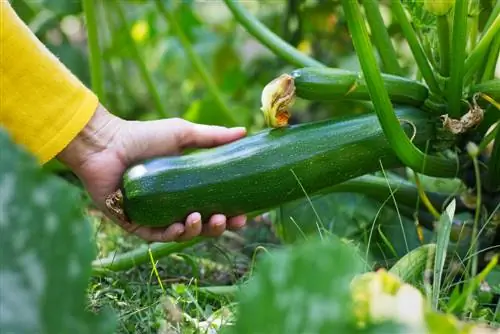
September is zucchini time
Cucumbers, zucchini, beans, salads, potatoes, leafy, root and tuber vegetables as well as numerous brassicas: you can still harvest plenty from the garden even in September. Make sure that the vegetables - with the exception of some types such as Brussels sprouts, which do not mind the cold - are stored or otherwise preserved or processed well before the first frost. You can also ripen the last tomatoes - even if they are still green - in a fruit bowl decorated with apples.
Think about the next gardening year and collect vegetable and flower seeds, which are best stored in small paper bags in an airy and dry place. Only cold-germinating plants need to be planted now because they need a cold stimulus to germinate: daylily, phlox, torch lily, monkshood or lady's mantle have to go into the bed in autumn. This also applies to most early-blooming bulb flowers such as tulips, crocuses and daffodils. You should plant these in the bed in October at the latest.
Perennial garden perennials such as larkspur, daisy and lupine are best propagated now by division; many trees can also be cut back from the end of September. The lawn continues to be mowed.
October
In October you harvest the last vegetables and late fruits such as quinces. You should also catch up on any work that may have been left behind in September:
- digging up harvested beds
- Sowing green manure
- Planting flower bulbs
- Sowing cold germinators
- Planting trees
- Bring potted plants to winter quarters
- Mulching beds and borders
It is also important to remove leaves regularly. This is particularly important on lawns, as rot can occur under the thick layer of leaves. However, you don't have to dispose of the leaves; you can use them to make valuable leaf humus. To do this, simply put the leaves on the compost, either alone or together with other garden waste. Now is also the right time to cut back faded perennial plants and grasses and pile up the roses.
This video shows very well what work needs to be done in October:

November
Even in November, clear away leaves so that the plants underneath don't suffocate. Finally, make the garden winter-proof by pulling weeds one last time and then spreading compost and mulch in the beds and protecting sensitive plants from the cold. Potted plants are best overwintered frost-free in cool winter quarters.
In November you can also plant many fruit trees and bushes and cut back existing fruit trees. You should also place glue rings around the trunks to prevent pest insects from overwintering. This measure should not be neglected, especially with apple trees.
Excursus
How do you optimally prepare your garden pond for winter?
Remove the water pump in late autumn. Clean and maintain them, then store them in a frost-free location until next spring. Also remove dead leaves. In winter, you can float a plastic ball on the surface of the water to keep the area ice-free.
Gardening in winter
Protection is the gardener's main concern in winter. Frost, snowfall, storms and hail pose a threat to the plants in the garden. Make sure that they are adequately protected. Also use the time to plan for the next year.
We are now planning and preparing for the coming gardening year, as the following video shows:

Frequently asked questions
I suffer from back pain, which makes it difficult for me to work in the bed. How can I make gardening easier?
In this case, a raised bed (or several) at a suitable height is probably the best solution.
Are there easier ways to remove root weeds from the beds?
Root weeds can be easily removed with a weed cutter without bending over.
How can I stop weeds from growing so I don't have to weed anymore?
You probably won't be able to completely banish weeds from the garden, but a weed fleece spread on the bed helps a lot. In addition, weeds rarely grow on mulched beds.
Tip
Unloved gardening work such as weeding or mowing the lawn can also be easily outsourced to schoolchildren or students who want to earn some extra money.

